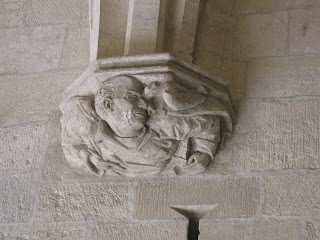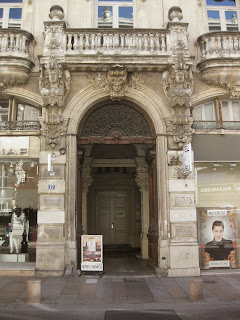Oct. 12
The French were out in force today.
Not right away, mind you, because it
seems Saturday starts out slow here. We went this way, that way on some little
streets to get to Les Halles, the city market. The streets at 11 a.m. were
pretty empty.
We stopped for breakfast around that
time at a place really called Joke & Co., a small cafe with a long list of
crepe choices and a dining room upstairs. We had the place to ourselves and sat
by a window. Some people walked by, but not many.
Joanna had crepes with a chestnut
topping. I had mine with Calvados.
I also finally got to have wine with
breakfast, a glass of a white that the proprietors said came from
Aix-en-Provence. I had asked for a white Cotes du Rhone, but they didn’t have
one. Maybe that was one of the jokes.
No complaints, though. The wine had
some flavor and went down reasonably well.
The Les Halles market is newer,
smaller, and less gritty than the markets in Valencia and Barcelona, but well
worth a stop. There are wine sellers, bars, lots of places that will shuck a
plate of oysters for you. We didn’t stop for oysters because Joanna doesn’t eat
raw fish, and we had just eaten crepes. But damn, they looked good.
One thing on the fish counter that I
had not seen before is aile de raie. It reminded Joanna of shark fin. I think
the name refers to the fin of a ray or a skate.
We picked up some very expensive
macarons for fun and some very cheap fruit for breakfast because we are going
to leave the hotel relatively early Sunday morning to get a 10:14 train back to
Paris.
In our wanderings on the way back to
the hotel, we found a 13th century synagogue next to Place de Jerusalem in what
was during the Middle Ages was the ghetto of Avignon. I believe the synagogue
is still used for marriages and possibly for regular sabbath services, but am
not sure.
The first big surprise of the day came
around our lunch time, which was in the middle of the afternoon. We went to the
Place de l’Horloge for some wine and cheese.
There were some tents set up in the
square, one with an exhibit about insects, another with a clown show, a couple
of others. An acrobat disguised as a giant red bug of some kind had huge stilts
that resembled lobster claws on his legs and arms and lumbered around the
crowd. At one point, he trapped a lady inside his four limbs.
We sat in the sun in front of one cafe
that ignored us. We went next door and got a white Cotes du Rhone and a cheese
plate.
This order should be a good bet in
France, because there are the three things the French really pride themselves
on: wine, cheese, and bread. I think French restaurateurs are transported to
the Netherlands, where they have to eat the food for two years, if they fuck up
one of those things.
Before we had polished off the cheese,
we heard drums. It seems there is a local festival this weekend involving
several hundred medieval reenactors. In the States, we have Civil War
reenactments, Revolutionary War, and my brother-in-law Mark goes back as far as
the French and Indian Wars. I believe some Americans also belong to a Society
for Creative Anachronism, but they are largely confined to Renaissance Faires.
But over here, they have knights in
mail and yeoman with crossbows.
They had drums and bagpipes, hunting
horns, and banners. The guys bringing up the rear were in white with red
crosses on their tunics. And they were really into it. I think they were
supposed to be the Templars, kind of the Marine Corps of the Crusades. The
Templars were scary in real life and these guys had their game faces on to
uphold the tradition.
The procession also included camp
followers, at least one jester, a couple of bishops, a cardinal, and maybe a
pope impersonator.
The whole group marched through the
Place of the Clock and went up to the plaza outside the papal palace, where
they clowned around for an hour or so. Some were chanting marching songs, or
maybe bawdy songs.
We watched a duel between two knights
with a third acting as referee. Whenever one tried a low blow or some other
infraction of the rules, the ref hit him with the flat of his sword.
A thief grabbed a woman’s pocketbook,
and the guards grabbed him, and then they all had a photo taken together. We
saw the Wife of Bath using a video camera.
After a while, the reenactors formed up
and marched back. Their route took them past the site of the old Templar
commandery of the city.
There is a sign there that I found the
other day. It’s right across the street from St. Agricol, which is the name of
that very old church named for the even older bishop.
We wandered around looking for a
restaurant in the evening. For all I know, there is no bad food in Avignon, but
we stayed away from the Place d’Horloge, because if there is substandard food,
it will be in a tourism navel like that.
Most of the menus offer five or six
choices of entree, generally something beef, something salmon, duck, and
tartare.
We wound up at a place on Rue
Bonneterie called Chez Rippert.
We got a bottle of red Cotes du Rhone
called Terres de Galets from a company or person named Gabriel . Meffre (yes,
with a point in the middle). It was good, but nowhere near as flavorful as the
wine we had last night.
The Galets had a mild fragrance and was
reasonably fruity with a little bite going down. After four or five sips it
started to grow on me and the aroma seemed to get stronger.
The flavor improved significantly once
the snails came. They were plump and garlicky. Escargots is one of the few dishes
that I enjoy with a strong garlic scent and flavor.
When we were choosing the main course,
I came across one with “pulpeaux.” I couldn’t remember what pulpeaux. Was it a
vegetable? Or meat without a backbone? Then I remembered.
I confirmed with the waiter, who spoke
some English, that pulpeaux is octopus. With an X on the end, it probably
referred to more than one, but I was not being punctilious. As long as it was
dead, I would eat it.
The dish turned out to be a brown broth
with carrots, potatoes, and little octopuses. It wasn’t exactly the comfort
food that we have been eating for days, probably because it wasn’t as fatty.
But it was very good.
Back at the hotel, we polished off the
bottle from Gabriel . Meffre with some of the macarons we bought at Les Halles.
I arranged a wake-up call for 6:30 to
make that 10:14 train without having to rush, and thus assured of my schedule,
slept the sleep of the mildly buzzed.
Back in Paris on Sunday afternoon,
staying in the Montmartre.
Be well, all.
Oct. 23
Larry,
According to your Grasshopper, my
walking Google, the people in Paris are very serious about their wine, cheese, and bread. Whoever screws up those three will be sent to Holland and eat
Dutch food for two years.
Fact or did he make that up?
Joanna
Oct. 23
Joanna,
When I saw he wrote that in one of his
e-mails, I was quite impressed.
The concept is so excellent, who cares
whether it's true or not?
Although I have seen a few lost-looking
souls wandering around Amsterdam muttering in French as they scoured the
streets for a decent loaf of bread and a drinkable bottle of wine (cheese isn't
a problem — while the Netherlands might not have the variety France does,
quality is hardly an issue), I don't know if their situation was self-imposed
or by judicial directive.
Unfortunately, some of these guys
became cooks at some of Amsterdam's most popular restaurants.
Who am I to argue with an older and
wiser man whose travel mileage is quickly catching up to mine?
We should discuss this further over a
bowl of laksa or hokkien mei in Singapore.
See you then!
Best,
Larry

























